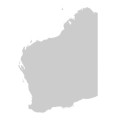Stenopetalum lineare
R.Br. ex DC. Narrow Thread-petalAnnual or rarely biennial herb to 50 cm high, at least base of plants covered in irregularly branched or stellate hairs. Basal leaves to 5(–10) cm long, pinnately lobed, lobes lanceolate to linear, toothed or entire; stem leaves to 10 cm long, pinnately- or 3-lobed to entire and thread-like. Sepals 3–6 mm long; petals 6–13 mm long, chocolate-brown to olive-green, claw linear, lamina oblong. Fruit oblong to slightly obovoid, 4–7 mm long, 1.5–2 mm wide; pedicels appressed to erect, usually 1–2 mm long. Flowers mostly spring.
LoM, MuM, Wim, GleP, VRiv, MSB, RobP, MuF, GipP, OtP, WaP, Gold, CVU, GGr, EGU, WPro, OtR. Scattered across Victoria but mostly in drier north and north-west areas.
Some plants may have moderately hairy upper stems and inflorescences, but the sepals always have scattered or at most patchy hairs (cf. S. velutinum).
Plants from coastal areas are often much more robust and spreading, with thick, sometimes fleshy leaves that are usually entire. These plants are quite distinct from the slender erect forms with slender or pinnately lobed leaves that are commonly encountered further inland. This coastal form is sometimes treated as a separate taxon, Stenopetalum lineare var. canescens Benth. However, coastal plants are not always distinct, ranging from slender and erect, robust and erect, and robust and spreading. Likewise, plants from inland sites are occasionally much more robust and erect. Hence, these robust plants may just be responding to favourable conditions. Similarly, the degree to which leaves are lobed appears to vary greatly between plants at both coastal and inland sites, and does not seem sufficient to distinguish taxa.
Entwisle, T.J. (1996). Brassicaceae. In: Walsh, N.G.; Entwisle, T.J., Flora of Victoria Vol. 3, Dicotyledons Winteraceae to Myrtaceae, pp. 399–459. Inkata Press, Melbourne.
 Spinning
Spinning



